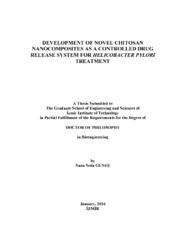Please use this identifier to cite or link to this item:
https://hdl.handle.net/11147/4854| Title: | Development of Novel Chitosan Nanocomposites as a Controlled Drug Release System for Helicobacter Pylori Treatment | Other Titles: | Helicobacter Pylori Tedavisine Yönelik Kontrollü İlaç Salım Sistemi Olarak Yenilikçi Kitosan Nanokompozitlerin Geliştirilmesi | Authors: | Güneş, Suna Seda | Advisors: | Tıhmınlıoğlu, Funda Yılmaz, Özlem |
Keywords: | Helicobacter pylori Controlled drug release Gastrointestinal system Minimum inhibition concentration Chitosan microspheres |
Publisher: | İzmir Institute of Technology Izmir Institute of Technology |
Source: | Güneş, S. S. (2016). Development of novel chitosan nanocomposites as a controlled drug release system for Helicobacter pylori treatment. Unpublished doctoral dissertation, İzmir Institute of Technology, İzmir, Turkey | Abstract: | Helicobacter pylori is one of the most common bacterial infection and responsible for gastroduodenal diseases in humans. Due to increasing failure rate of currently used antibiotic therapies, newer drugs and therapeutic approaches are needed. Therefore the use of encapsulated cinnamon bark oil is a promising approach for H. pylori eradication. The main objective of this dissertation was to develop a novel drug delivery system using chitosan and nanoclay containing cinnamon bark oil to be released in a controlled manner in gastrointestinal system for H. pylori eradication as an alternative or complementary to conventional antibiotic treatment. Minimum inhibition concentration (MIC) value of cinnamon bark oil was determined. Cinnamon bark oil loaded chitosan nanocomposite microspheres were produced by spray drying. The prepared microspheres were characterized for particle size & morphology, encapsulation efficiency, surface charge, mucoadhesion, degradation, swelling and drug release. Antimicrobial activity of the microspheres against H. pylori were investigated. In vitro cell viability of fibroblast and gastric epithelial cells were evaluated. In vitro cellular uptake and binding studies of microspheres were investigated by using gastric epithelial cells. MIC value of cinnamon bark oil was found as 8 μg/mL. Nanoclay incorporation decreased the biodegradation of nanocomposite microspheres and improved the release of cinnamon bark oil. Drug release mechanism was anomalous diffusion which refers to combination of diffusion and erosion controlled. The prepared microspheres showed strong mucoadhesive property. Oil released from prepared microspheres inhibited H. pylori growth. Although cinnamon oil showed cytotoxic effect above 31 μg/mL, the oil encapsulated chitosan microspheres did not show any cytotoxic effect on NIH3T3 and MKN45 cells. The prepared microspheres were able to get internalized into MKN45 cells and had great incorporation activity. The results of this study demonstrated that cinnamon bark oil loaded chitosan nanocomposites may serve as biocompatible and effective gastroretentive drug carrier for the treatment of H. pylori infection. Helicobacter pylori (H. pylori) enfeksiyonu, en yaygın bakteriyel enfeksiyonlardan biri olup insanlarda gastroduodenal rahatsızlıkların nedenidir. Mevcut antibiyotik tedavisinde tamamen bir eradikasyon sağlanamadığı için yeni ilaç ve tedavi yaklaşımlarına ihtiyaç vardır. Bu nedenle enkapsule edilmiş tarçın yağının kullanımı, H. pylori eradikasyonunda umut vaad etmektedir. Bu çalışmanın amacı, H. pylori eradikasyonu için geleneksel antibiyotik tedavilerine alternatif veya yardımcı olabilecek, gastrointestinal sistemde kontrollü salımını sağlayan tarçın yağı içeren kitosan nanokil temelli yenilikçi ilaç salım sistemlerinin geliştirilmesidir. Tarçın yağının H.pylori için MİK değeri belirlenmiştir. Tarçın yağı yüklü kitosan nanokompozit mikroküreler püskürtmeli kurutma ile üretilmiştir. Hazırlanan mikroküreler, partikül boyutu, morfoloji, enkapsulasyon verimi, mukoadezyon, şişme, biyodegradasyon açısından karakterize edilmiş ve ilaç salım çalışmaları yürütülmüştür.Kürelerden salınan tarçın yağının H.pylori üzerine inhibisyon etkisi araştırılmıştır. Tarçın yağı ve kitosan nanokompozitlerin üzerinde in vitro sitotoksik etkileri araştırılmış ve kürelerin MKN45 hücreleri tarafından hücresel alımları belirlenmiştir. Tarçın yağının MİK değeri 8 μg/mL olarak belirlenmiştir. Nanokil katkısı, küre degradasyonunu azaltmış ve salım profilinde iyileştirmiştir. İlaç salım mekanizması, difüzyon ve erozyon kontrolünün kombinasyonu olan “anomalous” difüzyon olarak belirlenmiştir. Hazırlanan mikrokürelerin mukoadeziv olduğu saptanmıştır. Mikrokürelerden salınan tarçın yağının H. pylori üremesini inhibe etmektedir. Tarçın yağı 31 μg/mL konsantrasyonun üzerinde toksik etki gösterirken, yağ yüklü mikroküreler, NIH3T3 ve MKN45 hücreleri üzerinde herhangi bir toksik etki göstermemiştir. Kitosan mikrokürelerin, MKN45 hücreleri tarafından alındığı, yüksek bağlanma aktivitesi gösterdiği ve gastrointestinal sistem için biyouyumlu olduğu belirlenmiştir. Böylece tarçın yağı yüklü mikrokürelerin H. pylori enfeksiyonu tedavisinde kontrollü ilaç salım sistemi olarak potansiyel bir aday olduğu belirlenmiştir. |
Description: | xiii, 150 leaves Thesis (Doctoral)--İzmir Institute of Technology, Bioengineering, İzmir, 2016 Full text release delayed at author's request until 2019.06.27 Text in English; Abstract: Turkish and English |
URI: | http://hdl.handle.net/11147/4854 |
| Appears in Collections: | Phd Degree / Doktora |
Files in This Item:
| File | Description | Size | Format | |
|---|---|---|---|---|
| T001511.pdf | DoctoralThesis | 6.27 MB | Adobe PDF |  View/Open |
CORE Recommender
Page view(s)
436
checked on Jul 28, 2025
Download(s)
274
checked on Jul 28, 2025
Google ScholarTM
Check
Items in GCRIS Repository are protected by copyright, with all rights reserved, unless otherwise indicated.